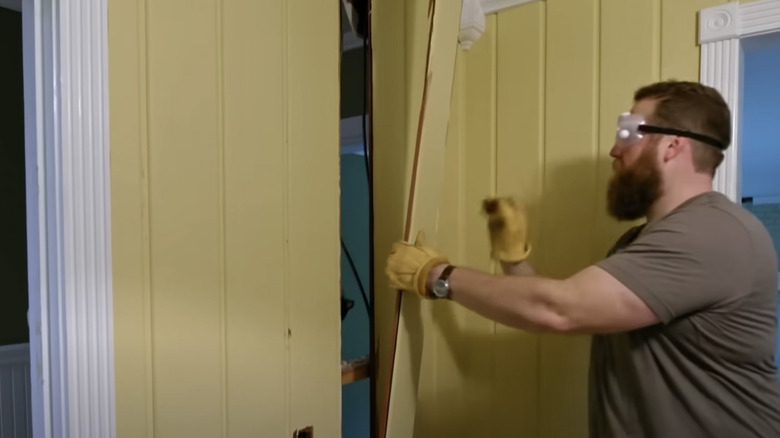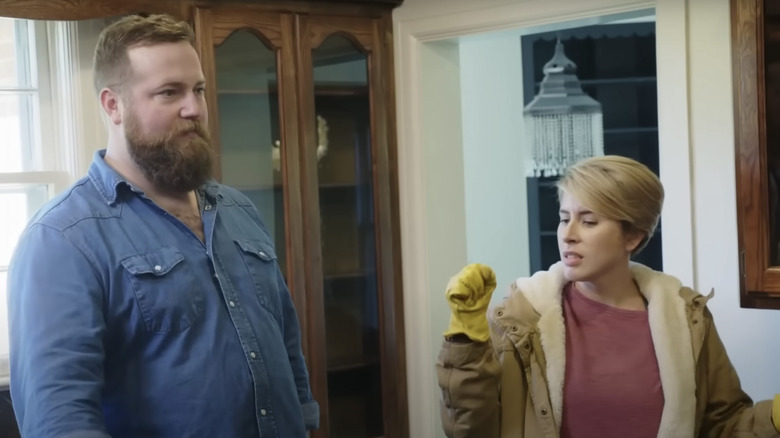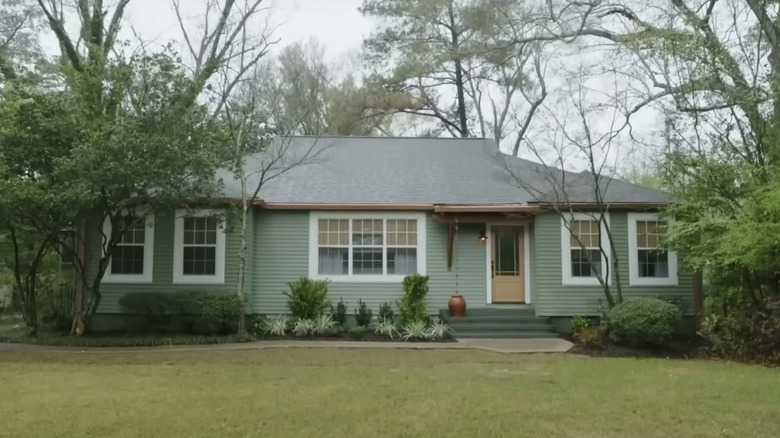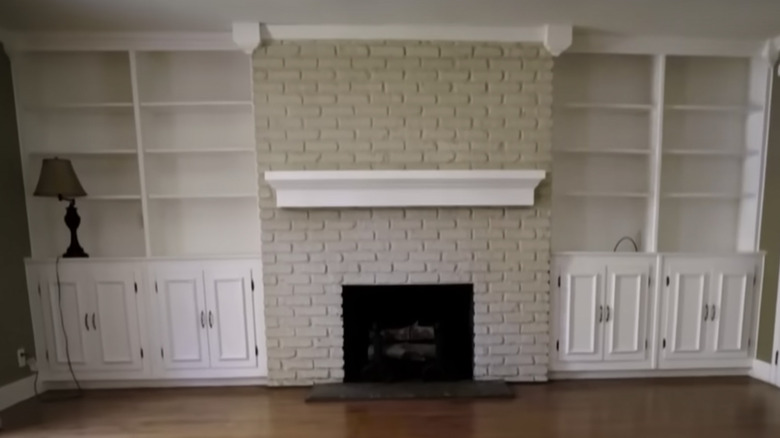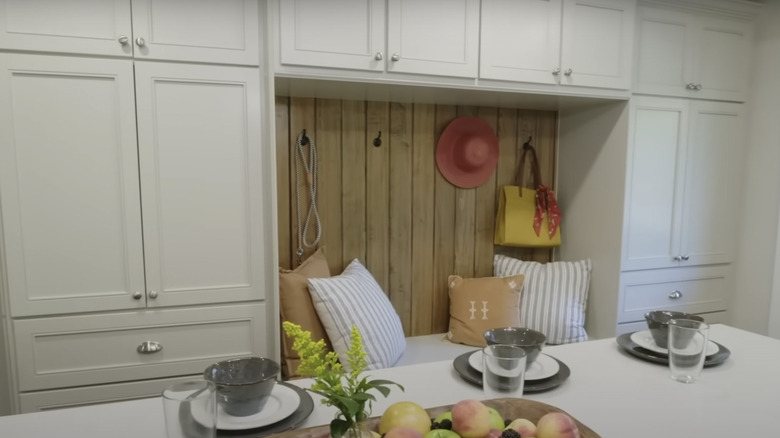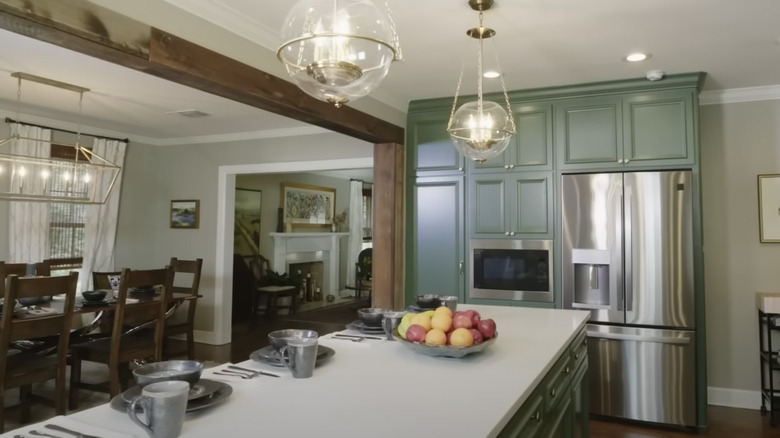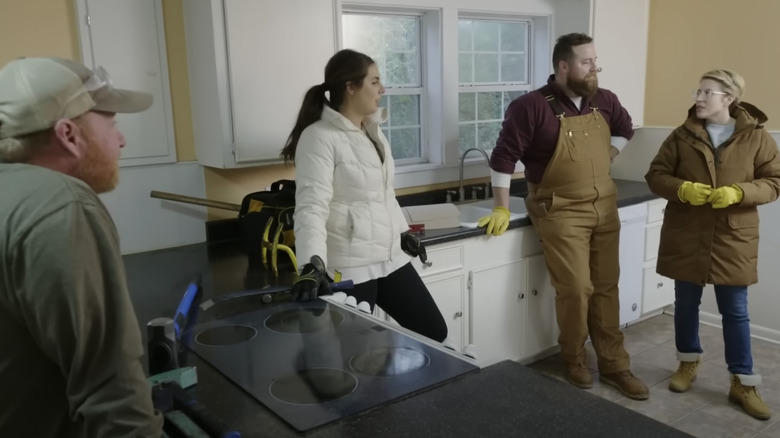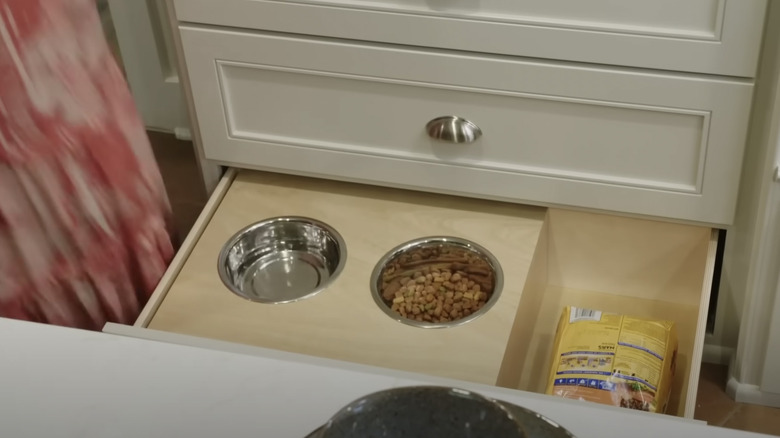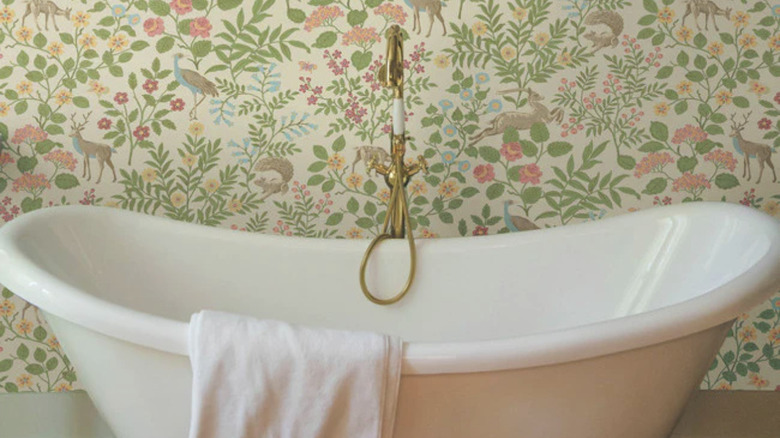12 Tips From Erin And Ben Napier You'll Want In Your Arsenal
Erin and Ben Napier are a loveable couple with great taste. Their HGTV show "Home Town" started airing in 2016 and was an instant hit. Fans of the show connected with the pair's southern charm, keen eye for design, and obvious love for each other. While many tune in to see what house in Laurel, Mississippi, will be getting a makeover each week, most of us just love hanging out with Ben and Erin.
After marrying, the couple moved to Erin's hometown and purchased a 1925 craftsman cottage. The couple managed to keep the home's character intact while renovating it for modern life, which caught the eye of producers for the popular design channel. Unlike some other famous design couples, the Napiers tend to focus on realistic advice that most of us could (and should!) implement at home. We watched hours of "Home Town" to gather the best advice. Here's what you need to know.
1. Investigate load-bearing walls before tearing them down
Something that isn't discussed enough on reality renovation shows is the importance of load-bearing walls. Even if the floor plan is talked about off-camera by designers, viewers typically don't get to see the consideration that needs to go into moving a wall. The great thing about "Home Town" is Ben and Erin usually loop viewers into this important conversation. This way, if you were planning to do renovation at home and wanted to change a wall's position, you know the right questions to ask your contractors. A load-bearing wall is exactly what it sounds like: It supports the upper workings of the home, be it the roof or the second story. If you removed it, the house's weak point would no longer be structurally sound and likely collapse.
Yet these walls don't always have to remain untouched. If you do enough planning, you can still move them (or change their size) without doing any damage to the structural integrity of your home. The best tip that Ben gives viewers is to reinforce the ceiling with a beam before tearing down the wall. This way, the force coming down from the ceiling can be distributed along the beam to the corners of the frame, instead of straight down into the ground. Without experience, this feat of engineering can be tricky to DIY, yet most general contractors should be able to complete it without hassle.
2. Be realistic about the amount of lawn upkeep you want
Overflowing flowerbeds, big trees, fountains, and benches can all add to a home's curb appeal. But how likely are you to care for all these additions daily? Something that Erin and Ben are great about is working with clients to create realistic lawn care plans. If a client lacks a green thumb, the pair scales back their plans to make things more manageable.
When we are creating our gardens, we should do the same. It's easy to get carried away when thinking about what we would love to have in our yards, but we should be thinking about our daily upkeep commitment instead. If you love gardening and plan to spend each Saturday working on landscaping, pulling weeds, mulching the beds, and removing pests from your tomato plant, go for it. Yet if you're more of a "hire a lawn company to come once a month" type of person, planting high-maintenance things (or simply lots of plants that need more than just watering) will drive you crazy. The best advice is to start small, see how you do, and build your way up from there.
3. Make a demolition plan
Most HGTV programs show "demo day" as mindless smashing without much discussion beforehand. It looks kind of fun, but its overall safety is a bit questionable. In contrast to this, Ben and Erin always seem to plan ahead. At least, they typically show the viewers the planning conversation that takes place. Making a demolition plan is important to ensure the safety of workers, comply with regulations, minimize costs, and carry out the demolition efficiently and sustainably. Because once something is smashed, you can't "un-smash" it. Thinking ahead can save you a lot of stress.
On "Home Town," we see a quick conversation about the demolition order. Yet behind the scenes, way more planning is likely going on. Before you start razing things at home, take a few moments to create a detailed plan. A good demolition plan outlines the steps that will be taken to mitigate risks and hazards associated with the demolition. This could be identifying potential dangers such as asbestos (often found in older homes), underground utilities like water lines or electric cables, or unstable structures. Once you know what's there, you make a plan to demolish everything safely.
4. Be realistic about dealbreakers in your budget
If money were no factor, it would be pretty easy for most of us to close our eyes and imagine exactly what our dream home would look like. Yet money is a factor when we are not dreaming. When renovating our homes, it's often the most realistic one. The Napiers are great at accommodating the homeowners on their show as best they can budget-wise, but they are still realistic.
In Season 5, Episode 10, When a couple was in love with nearly every aspect of a home except for its exterior color, they thought repainting it would be a breeze. The reality of the situation was that the home's siding was aluminum. This meant that the crew first needed to coat the entire house in a special primer for the paint color to stick. This significantly increased the job's overall price to a cool $35,000. Because this was such a sizeable chunk of the client's budget, it was suddenly a dealbreaker. Ben and Erin led the couple away from blowing their money on something that could be fixed in another way. Instead, they chose to change the look of the house's exterior by adding copper and wooden contrasts instead.
If you want to change something at home but find it's way out of your budget, don't give up hope. Instead, step back like the Napiers to decide if a less expensive modification could create a similar outcome.
5. Never work in unsafe weather
Sure, a deadline is a deadline, but you should always account for unsafe weather when building your construction timeline. Ben and Erin recognize this. In Season 3, Episode 13, they called off construction for the deck they planned to build until it was sunny again. While the pair is shown in full rain gear, verbally walking through what they plan to do with the area, no physical work is completed. This is an important safety consideration and also very practical.
Storms can create unsafe working conditions by increasing the risk of injuries or accidents for workers. Slippery surfaces can make it difficult to maintain balance, while water can cause electrical hazards, which can cause severe injury and even death in some cases. Rain can also damage construction materials, making them unusable and adding additional costs for replacement. For example, wood can warp and twist, while concrete and mortar can wash away or become diluted, affecting the structural integrity of the building. By choosing to delay construction, Ben and Erin will save both time and money in the end by avoiding all of these things. While working on your projects at home, it's best to follow their lead and take the day off (or work inside) during bad weather.
6. Use trim to make a home seem historically appropriate
Trim is a great way to add historical character to a home. When stepping back in time, things like mantles, crown moldings, and baseboards can go a long way. Yet, in some houses, the trim doesn't look fantastic because it's too modern. This is especially true if it was added aftermarket and the previous owners didn't know what they were doing. To bring things back from the dead in Season 3, Episode 13, Ben and Erin recommend adding a mantle to the fireplace to center it and make it feel cozier. The built-in bookshelves looked sleek but still needed new handles and finishing to match the period of the home.
If you struggle with balancing modern and historic elements when revitalizing your home, start with the basics. You should select materials that are appropriate for the style of the home. For example, if the house is Victorian-era, choose ornate trim made from wood. It can always be painted to match its surroundings, but you shouldn't use metal or stone if it's not period-appropriate. To that end, choose trim colors that were commonly used during the era of the home. If it's a Colonial, choose white or off-white trim to match the period. Finally, if the house has any original trim, try to match it as closely as possible. This will help maintain the historical integrity of the home.
7. Varnish outdoor furniture so it lasts longer
When revealing their hard work in Season 3, Episode 13, Erin mentions that she took the homeowner's bench and made it into a porch swing. The bench was a precious family heirloom passed down over the generations, so Erin made a special point to emphasize that she varnished it for outdoor use. This is important, as outdoor furniture is constantly exposed to the elements. To keep it safe, varnish creates a protective layer on the furniture's surface, shielding it from these harsh weather conditions. This protection helps to prevent the wood from cracking, warping, or rotting, which can shorten the life of the furniture.
Yet outdoor furniture isn't only fighting against the elements. Something like a porch swing would also be subject to lots of wear and tear from regular use, which can cause scratches and dents. Varnish creates a hard, durable surface that is resistant to this type of damage, helping the furniture look new for longer. In addition, most of us would want to keep something of sentimental value looking as great as possible. Varnishing outdoor furniture enhances the natural beauty of the wood. The varnish can deepen the color of the wood and provide a glossy, polished finish. We see this in the episode, as the final swing looks significantly more high-end than when it started.
8. Use wood to warm up sterile places
Gray, black, and white are chic colors for modern design, but using them on their own can rob a living space of its warmth. To avoid an area feeling too sterile, Erin likes to add wood to give it a lively boost. The earthy tones of lumber have a natural warmth that makes a space feel cozy and inviting. Whether it's the reddish-brown hues of cherry or the golden tones of oak, the colors offset the coolness of other neutral tones to create a great ambiance.
In Season 5, Episode 10, Erin put wooden beams across the top of the kitchen to offset the cooler tones of the countertops and cabinets. The nook near the kitchen door that acts as a mudroom has wooden paneling across the back. Erin also chose to style the space with wooden seats at the dine-in bar. Finally, using so much wood throughout the space allowed her to use rich terra cotta tiles on the floor instead of the cooler colors the client originally considered. Because of all the browns from the wood, the tiles didn't look out of place. Even if you love cooler colors, consider following suit and using wood as a base to elevate the room's overall aesthetic temperature.
9. You don't have to renovate the entire house
Something refreshing about the work on "Home Town" is that Ben and Erin don't always renovate the entire house. For those of us watching at home, this is a more realistic way to approach any construction we do in our homes. We might save for years just to renovate our kitchens, while plenty of reality renovation homeowners seem to have hundreds of thousands of dollars for complete makeovers at once. A breath of fresh air, the Napiers seem to operate on a budget model that is more attainable for most of us. That is, they encourage you to spend the majority of your budget on the spaces you use the most, like the kitchen, bathroom, or family room.
The rest of the rooms in the house might not need to be completely torn apart to look a thousand times better. Instead, these other spaces might just need a fresh coat of paint and a deep clean. Maybe a new light fixture if you are feeling really fancy. When setting your expectations, take a page out of the Napiers' book and spend your money where you will get the most daily return on your investment.
10. Wear total protection for demo day
"Demo day," a phrase made popular by another very likable HGTV couple, is one of the most exciting parts of the renovation process. There is nothing quite like seeing the hammers fly and the old, ugly bits of a home fall away. Yet, on some renovation shows, safety seems like an afterthought. At the very least, it's not discussed on camera. While we might see most hosts wearing safety glasses to keep debris out of their eyes, that is usually it. Erin and Ben do things a bit differently. On most episodes, you'll see that the Napiers not only wear gloves and glasses but long sleeves and boots, too.
Covering your entire body during demolition is very important. It might be better for the cameras to wear a cute outfit while knocking down cabinets, but safety must come first when you are tearing things up in your own home. The glasses keep your eyes safe, and the gloves protect your hands from splinters. The deconstruction might also aggravate old chemicals in the walls, so covering as much of your skin as possible is safest.
The boots (preferably steel-toed if you have them) protect your feet from being crushed by any heavier falling debris. This kind of PPE (personal protective equipment) is the norm on all construction sites and should be followed at home if you don't want to make a trip to the ER.
11. Create spaces for your pets
When planning a renovation, keep your furry friends' needs in mind, too. Misplaced dog bowls, litter boxes, and the like can "disrupt" the flow of your home if they are lying out in the open as tripping hazards. As you think about tweaking aspects of your living space for your everyday convenience, consider how to incorporate each family member. Ben and Erin did this effortlessly by installing a "doggie drawer" in the kitchen of their remodel.
When it's time to eat, the homeowners can pull out the drawer (which is the perfect height for their dog) and lock it. This way, the dog can enjoy his meal in the same spot daily. Yet when dinner is over, the drawer can be pushed shut, and the bowls aren't a tripping hazard for the rest of the day. Minor tweaks like this can go a long way toward your convenience and your pet's overall happiness. The Napiers also installed a doggie door in this episode, so the pet could come and go as he pleased. When recreating the idea at home, you might do the same or go further by seting up a private nook for your pet, perhaps by refurbishing the downstairs closet into an at-home pet hotel.
12. Use peel-and-stick wallpaper to make your house a cozy garden retreat
When Ben and Erin aren't filming episodes of "Home Town," they are working hard behind the scenes building their home décor business, Erin and Ben Co. In 2023, Erin proudly announced her most recent venture, a peel-and-stick wallpaper collection through York Wallcoverings. "It's been years in the making, and I'm thrilled to announce my professional quality US-made peel-and-stick wallpaper collection," Napier wrote on her Instagram. "Every design is a homage to heirloom wallpaper patterns of the early 20th century in multiple modern colorways..."
Prices for the line are varied, as the woodland floral roll is $70, while the scenic pastures mural roll comes in at $395. No matter your design taste or overall budget, there is a wallpaper option that will work for you. Whatever design you choose, peel-and-stick wallpaper is easy to install, so even the most inexperienced DIY decorators can have luck transforming their home into a lush oasis. It's also a friend to renters, as it's made to not damage the wall underneath and can easily be removed before moving out. If you're interested in making your home look a bit more like the beautiful restorations on "Home Town," this wallpaper line makes it easier than ever.

